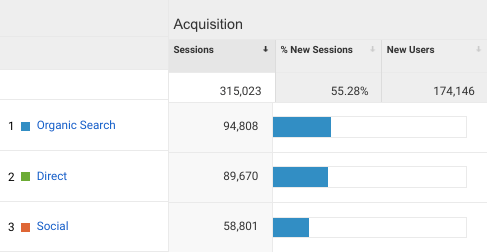What is Direct Traffic and How to Track It?
UFO, Holy Grail, 9/11, vaccination, Illuminati and NWO are just some of the biggest mysteries of this century. There’s one more that gives some of us sleepless nights.
It’s the source of direct traffic in Google Analytics.
Direct source our traffic has been a subject of a debate since many years. Some believe they know what the source of direct traffic is and some are far from such conclusions.
The truth is out there. Let me explain to you how we found sources of direct traffic using our social media monitoring tool, Brand24.
Understanding Direct Traffic
It can be said that direct traffic happens when Google Alerts is unable to identify a source of traffic. Below you can find just some examples of such a situation:
- Typing in a URL.
- Accessing a link from bookmarks.
- Clicking a link in a messaging app.
- Clicking a link in a PDF, .doc, or other documents.
- Clicking a link in a mobile app like Facebook or Twitter.
- Clicking a shortened link.
- Accessing a link organically via some browsers.
- + more, much more.
Here’s a short video that does a pretty good job of explaining direct traffic to your website, some common sources, and how to see where it comes from!
There are two things about direct traffic. The good one is that direct traffic often makes a considerable part of overall website traffic.

The bad thing is that it’s hard to identify where does it come from.
There are so many options that identifying 100% sources of direct traffic is impossible. For example, someone might have mentioned your website address in a Quora comment, in a social media post, on a website and elsewhere.
You can minimize the risk of direct traffic by creating dedicated links that are easily trackable by Google Analytics. To do so, you can use Campaign URL Builder from Google (known as URL builder previously).
But that’s a story for another occasion.
How To Find Direct Traffic Sources
One way to identify direct traffic sources is to use a social media monitoring tool like Brand24.
It’s quite simple. Social media monitoring tracks in real time all online mentions of predefined keywords. You can, for example, monitor your company name.
Start monitoring your direct traffic!
Brand24 lets you uncover the source of most of your direct traffic by linking it to news stories, blog posts, social media posts, etc.
Here’s an example.
In March, we noticed an enormous increase in new visitors on brand24.com. The vast majority of them was categorized as direct traffic. Google Analytics was helpless.

Using our own tool we were able to connect the dots. One of the keywords we monitor is our company name, brand24. To uncover direct traffic sources, we went to our tool. On March 1st, there was a significant increase in social media reach of brand24 mentions.

The green line represents social media reach of mentions and the blue line stands for the number of mentions. The graph clearly shows that there wasn’t a significant increase in mentions volume. The big increase was in the social media reach of these mentions.
It means that brand24 was mentioned by sources of a considerable social media reach. In Brand24, reach is an algorithm based on the size of a source’s audience: the number of followers and visitors.
After having a closer look at the case in the Analysis tab, we found out that brand24 was mentioned by Inc.com.
By appearing in their article, we were exposed to their huge audience who checked brand24.com
What is direct traffic vs organic traffic vs referral traffic?
Direct traffic and organic traffic are two distinct types of web traffic that indicate how visitors are arriving at a website. Understanding the difference between them is crucial for analyzing a site’s performance and identifying areas for improvement.
Direct traffic refers to instances where users directly access a website by typing the URL into their browser or clicking on a bookmark. This type of traffic does not rely on search engines or any other external sources to reach the site. Direct traffic data can be useful for campaign tracking and user engagement analysis.
However, you need to be aware of unnecessary direct traffic, which may arise from spam, bots, no secure protocol, or inaccurate tracking.
Organic traffic, on the other hand, refers to users who discover a website through search engines like Google, Bing, or Yahoo. These users find the site by entering relevant keywords and clicking on the search results. Organic search engine traffic is a valuable traffic source as it often indicates that the site’s content is relevant and valuable to users searching for specific information.
Referral traffic is another type of web traffic that occurs when users click on a link to your website from an external source, such as another website, blog, or social media platform. This type of traffic provides valuable insights into how well your website is connected to other online platforms and which external sources are driving visitors to your site. Referral traffic can help you identify potential partnerships or collaborations and understand the effectiveness of your marketing efforts in attracting visitors from other sites.
To track referral traffic, use web analytics tools like Google Analytics, which will mine referral data and provide insights into the external sources driving visitors to your site.
In summary, direct, organic, and referral traffic are three important types of web traffic that provide insights into how users are arriving at your website:
Direct traffic: Users directly access the website by typing the URL or clicking on a bookmark.
Organic traffic: Users discover the website through search engines by entering relevant keywords.
Referral traffic: Users visit the website by clicking on links from external sources like other websites non web documents, blogs, or social media platforms.
How to Increase Direct Traffic
To get more direct traffic, focus on increasing brand awareness and making your website memorable to users. Here’s why it’s essential and some strategies to achieve it.
Importance of direct traffic:
- Indicates brand loyalty: Users directly visiting your website are likely familiar with your brand and demonstrate a level of trust and loyalty.
- Higher engagement: Direct visitors tend to spend more time on your site and engage with the content, as they intentionally navigate to your site.
- Bypasses competition: By directly accessing your site, users skip search engine result pages, where competitors might rank higher.
Strategies to increase direct traffic:
- Build a strong brand: Invest in your brand identity, ensuring it’s consistent across all marketing materials and channels.
- Memorable domain name: Choose a simple, easy-to-remember domain name to encourage users to type it directly into their browsers.
- Offline marketing: Utilize offline marketing strategies such as print ads, billboards, or radio to increase brand awareness and drive direct traffic.
- Provide valuable content: Regularly publish high-quality, engaging content that encourages users to return directly to your site for updates.
- Encourage bookmarking: Encourage visitors to bookmark your website, making it easier for them to access it directly.
- Build an email list: Create an email marketing campaign to drive traffic directly to your site and keep your brand top of mind.
- Utilize social media: Actively engage with your audience on social media platforms to increase brand recognition and encourage direct visits.Minimizing Direct TrafficThis is a bit contradictory to the previous paragraph. Why would you want to minimize direct traffic? After all, the more organic traffic, the merrier. Well, not in this case. You need to separate the grain from the chaff.While direct traffic is an important indicator of user engagement, it’s essential to minimize unnecessary direct traffic resulting from inaccurate tracking or other factors. To achieve this, website owners should focus on creating trackable links for their marketing campaigns using tools like Google’s Campaign URL Builder. This allows for better monitoring of direct and organic traffic sources and a more accurate analysis of their website’s performance.Additionally, website owners should regularly audit their analytics setup to ensure that tracking codes are functioning correctly and that the site uses secure protocols. By taking these measures, they can gain a better understanding of their audience’s behavior and optimize their marketing strategies accordingly.
Conclusion
This is how we track direct traffic sources on a daily basis. One of the features of the tool is Influence of social media authors.
It sorts all sources mentioning your keywords according to their social media reach. This is how you can track direct traffic sources.
If you feel, it’s something you need, you can try Brand24.
It’s completely free. No credit card required.
FAQ
Q: Is direct website traffic good?
A: Direct website traffic can be beneficial as it indicates that users are familiar with your website and are directly accessing it through the URL or bookmarks. However, it’s essential to monitor direct traffic for potential issues such as spam, bots, or inaccurate tracking.
Q: Why am I getting direct traffic?
A: Direct traffic can result from various sources, including users typing your website URL directly into their browser, accessing it through bookmarks, or clicking links from emails or messaging apps like Facebook Messenger. Some direct traffic may also be generated by users visiting from sources where the referrer data is not passed on, like HTTPS to HTTP or incognito browsing.
Q: How much website traffic should be direct?
A: There is no specific percentage of website traffic that should be direct, as it depends on your website’s nature, industry, and target audience. A healthy mix of direct traffic, organic search traffic, and referral traffic is typically ideal for a well-rounded online presence. As a rule of thumb, if about one-fifth of the total traffic is direct traffic, it’s fine.
Related articles
Top Reads
Brand Monitoring: Tools & Guide for 2026
Brand Awareness Strategy [The Ultimate Guide for 2026]
The Best AI Hashtag Tracker and Other Hashtag Tracking Tools [2026]
Social Media Reach: How to Measure & Improve It in 2026?
X (Twitter) Analytics Tools: The 10 Best to Try in 2026
Sentiment Analysis: What is it & Why do You Need it in 2026?
Share of Voice: Definition, Calculation, Tools [2026 Guide]
Brand Reputation Management: 6 Expert Tips for 2026
A Complete Guide to AI Social Media Analysis [2025]
How to See How Many Times a Hashtag Was Used on X (Twitter)
Start Social Listening!
Get the Brand24 trial and start social listening like a PRO.


